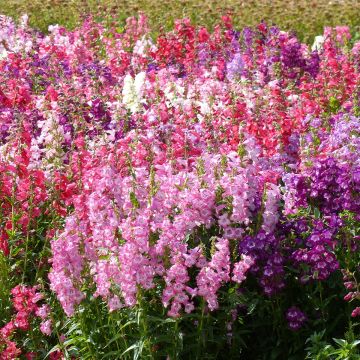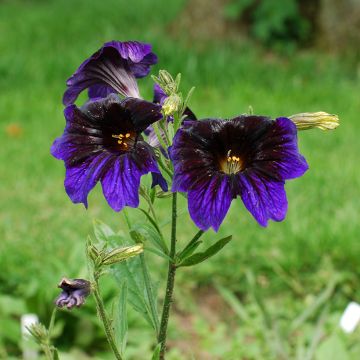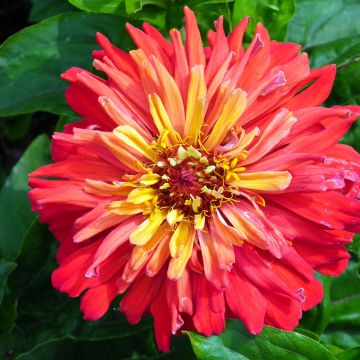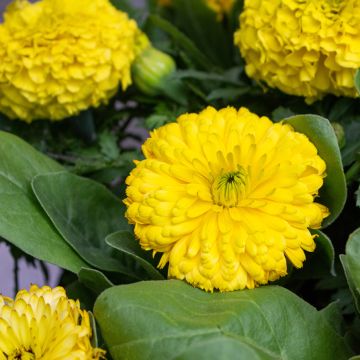

Strelitzia reginae Humilis
Strelitzia reginae Humilis
Strelitzia reginae Humilis
Bird of paradise, Crane flower
Out of the 4 seeds, only 1 has germinated and a little shoot has grown for now. To be seen in the future.
Jose C., 20/09/2020
This plant carries a 6 months recovery warranty
More information
We guarantee the quality of our plants for a full growing cycle, and will replace at our expense any plant that fails to recover under normal climatic and planting conditions.
Seed-only orders are dispatched by sealed envelope. The delivery charge for seed-only orders is €3.90.
Delivery to Corse prohibited: UE law prohibits the import of this plant from mainland France to Corse as part of the fight against Xylella fastidiosa. Please accept our sincere apologies.
More information
Does this plant fit my garden?
Set up your Plantfit profile →
Description
Strelitzia reginae 'Humilis' is a dwarf bird of paradise. It is a magnificent exotic plant, whose flowers resemble the plumage of birds of paradise. This plant is a true delight in the heart of winter for those who know how to provide it with a bit of warmth and care.
Strelitzia reginae is an exotic perennial plant native to South Africa. It belongs to the Strelitziaceae family. Its subtropical origin explains its low resistance to cold (minimum 5°C (41°F)), which prevents it from being cultivated outdoors all year round. It needs the shelter of a heated greenhouse, a conservatory, or the house to produce its magnificent paradisiacal flowering. When well cultivated, this dwarf strelitzia will flower from December to May.
The foliage is in the form of a tuft of overlapping leaves. Carried by long petioles of about 50cm (20in), the leaves are tough, oblong, and measure from 20 to 50cm (8 to 20in).
The floral stems emerge from the axils of the leaves. The flower, 10 to 12cm (4 to 5in) long, is composed of a large pointed green spathe marked with dark red, carried by a long and thick vertical stem. From this spathe, the bright orange sepals and the blue petals of the corolla emerge, somewhat like a fan opening. Strelitzia owes its common name to the resemblance of its flowers to the spiky plumage of birds of paradise during their courtship display.
This dwarf bird of paradise should be grown in rich and well-drained substrate. To achieve this, mix one-third of good garden soil with one-third of leaf compost and one-third of bark. This dwarf variety does not exceed 90cm (35in) in height and adapts very well to cultivation in large pots.
Strelitzia needs warmth more than sunlight. It will be content with the low light of a house in winter, but needs to avoid temperatures below 12°C (53.6°F). In summer, place it on a patio or balcony. Water it abundantly twice a week in summer and once every 15 days in winter. The flowers are perfect in beautiful exotic bouquets.
Report an error about the product description
Flowering
Foliage
Plant habit
Botanical data
Strelitzia
reginae
Humilis
Strelitziaceae
Bird of paradise, Crane flower
Cultivar or hybrid
Other Thompson and Morgan seeds
Planting and care
Soak the seeds in warm water for 36 hours before sowing and carefully remove the orange fuzz from the side of the seed as it can inhibit germination if left on.
Sow from January to December in a 12cm (5in) diameter pot. Use high-quality compost and sieve it on the surface to bind the seed to its substrate. Before sowing, lightly firm the compost with a board. Sow one seed per pot. Cover the seeds with a good centimetre of compost, lightly firm, and water generously with a fine spray. Place your pots in the dark, at a temperature of 21 to 24°C (70 to 75°F).
The seeds will take 1 to 6 months to germinate. Regularly monitor your sowings. As soon as a seed germinates, place the pot in light without direct sunlight. Keep the compost moist but not excessively during growth.
Repot your plants every two years in September. Water them abundantly twice a week in summer and once every 15 days in winter. From February to the end of August, water the base of the plants with liquid fertiliser twice a month. The first flowering usually occurs during the third year of cultivation.
Monitor attacks from scale insects that can spoil the beauty of the plant.
Sowing period
Intended location
-
, onOrder confirmed
Reply from on Promesse de fleurs
Flower seeds
Haven't found what you were looking for?
Hardiness is the lowest winter temperature a plant can endure without suffering serious damage or even dying. However, hardiness is affected by location (a sheltered area, such as a patio), protection (winter cover) and soil type (hardiness is improved by well-drained soil).

Photo Sharing Terms & Conditions
In order to encourage gardeners to interact and share their experiences, Promesse de fleurs offers various media enabling content to be uploaded onto its Site - in particular via the ‘Photo sharing’ module.
The User agrees to refrain from:
- Posting any content that is illegal, prejudicial, insulting, racist, inciteful to hatred, revisionist, contrary to public decency, that infringes on privacy or on the privacy rights of third parties, in particular the publicity rights of persons and goods, intellectual property rights, or the right to privacy.
- Submitting content on behalf of a third party;
- Impersonate the identity of a third party and/or publish any personal information about a third party;
In general, the User undertakes to refrain from any unethical behaviour.
All Content (in particular text, comments, files, images, photos, videos, creative works, etc.), which may be subject to property or intellectual property rights, image or other private rights, shall remain the property of the User, subject to the limited rights granted by the terms of the licence granted by Promesse de fleurs as stated below. Users are at liberty to publish or not to publish such Content on the Site, notably via the ‘Photo Sharing’ facility, and accept that this Content shall be made public and freely accessible, notably on the Internet.
Users further acknowledge, undertake to have ,and guarantee that they hold all necessary rights and permissions to publish such material on the Site, in particular with regard to the legislation in force pertaining to any privacy, property, intellectual property, image, or contractual rights, or rights of any other nature. By publishing such Content on the Site, Users acknowledge accepting full liability as publishers of the Content within the meaning of the law, and grant Promesse de fleurs, free of charge, an inclusive, worldwide licence for the said Content for the entire duration of its publication, including all reproduction, representation, up/downloading, displaying, performing, transmission, and storage rights.
Users also grant permission for their name to be linked to the Content and accept that this link may not always be made available.
By engaging in posting material, Users consent to their Content becoming automatically accessible on the Internet, in particular on other sites and/or blogs and/or web pages of the Promesse de fleurs site, including in particular social pages and the Promesse de fleurs catalogue.
Users may secure the removal of entrusted content free of charge by issuing a simple request via our contact form.
The flowering period indicated on our website applies to countries and regions located in USDA zone 8 (France, the United Kingdom, Ireland, the Netherlands, etc.)
It will vary according to where you live:
- In zones 9 to 10 (Italy, Spain, Greece, etc.), flowering will occur about 2 to 4 weeks earlier.
- In zones 6 to 7 (Germany, Poland, Slovenia, and lower mountainous regions), flowering will be delayed by 2 to 3 weeks.
- In zone 5 (Central Europe, Scandinavia), blooming will be delayed by 3 to 5 weeks.
In temperate climates, pruning of spring-flowering shrubs (forsythia, spireas, etc.) should be done just after flowering.
Pruning of summer-flowering shrubs (Indian Lilac, Perovskia, etc.) can be done in winter or spring.
In cold regions as well as with frost-sensitive plants, avoid pruning too early when severe frosts may still occur.
The planting period indicated on our website applies to countries and regions located in USDA zone 8 (France, United Kingdom, Ireland, Netherlands).
It will vary according to where you live:
- In Mediterranean zones (Marseille, Madrid, Milan, etc.), autumn and winter are the best planting periods.
- In continental zones (Strasbourg, Munich, Vienna, etc.), delay planting by 2 to 3 weeks in spring and bring it forward by 2 to 4 weeks in autumn.
- In mountainous regions (the Alps, Pyrenees, Carpathians, etc.), it is best to plant in late spring (May-June) or late summer (August-September).
The harvesting period indicated on our website applies to countries and regions in USDA zone 8 (France, England, Ireland, the Netherlands).
In colder areas (Scandinavia, Poland, Austria...) fruit and vegetable harvests are likely to be delayed by 3-4 weeks.
In warmer areas (Italy, Spain, Greece, etc.), harvesting will probably take place earlier, depending on weather conditions.
The sowing periods indicated on our website apply to countries and regions within USDA Zone 8 (France, UK, Ireland, Netherlands).
In colder areas (Scandinavia, Poland, Austria...), delay any outdoor sowing by 3-4 weeks, or sow under glass.
In warmer climes (Italy, Spain, Greece, etc.), bring outdoor sowing forward by a few weeks.























































